CdS/CdS0.48Se0.52轴向异质结纳米线的非对称光波导及双波长激射∗
李丹 梁君武 刘华伟 张学红 万强 张清林†潘安练‡
1)(湖南大学物理与微电子科学学院,微纳结构物理与应用技术湖南省重点实验室,长沙 410082)
2)(玉林师范学院物理科学与工程技术学院,玉林 537000)
(2016年11月6日收到;2016年12月17日收到修改稿)
CdS/CdS0.48Se0.52轴向异质结纳米线的非对称光波导及双波长激射∗
李丹1)梁君武2)刘华伟1)张学红1)万强1)张清林1)†潘安练1)‡
1)(湖南大学物理与微电子科学学院,微纳结构物理与应用技术湖南省重点实验室,长沙 410082)
2)(玉林师范学院物理科学与工程技术学院,玉林 537000)
(2016年11月6日收到;2016年12月17日收到修改稿)
本文利用可控的化学气相沉积法合成了高质量的轴向CdS/CdS0.48Se0.52异质结纳米线.扫描电子显微镜表征发现这些纳米线具有光滑的表面结构;荧光显微图像表明纳米线由CdS和CdSSe两部分沿轴向构成;微区荧光光谱研究表明界面区具有高的结晶质量;光波导研究表明异质结纳米线具有非对称光传输特性;进一步的激发功率依赖的荧光光谱研究表明此结构可以实现红和绿双波长激射,并且红色激射阈值低于绿色激射.理论模拟表明波导光可以两相间有效传输.
纳米线,异质结,光波导,激光器
1 引 言
半导体异质结构是各种传统电学和光电器件的重要构成部分,例如:半导体激光器[1]、谐振隧道二极管[2]、高电子迁移率晶体管[3]、光电探测器[4]等.随着光电器件对集成度和性能的要求日益提高,微型化的半导体异质结越来越受到关注.由于纳米线具有高效的应力弛豫能力,使得在晶格失配率大的不同相间形成无缺陷的异质结,所以一维半导体纳米线被认为是构成纳米异质结构的最理想体系[5,6].一维半导体纳米线具有优异的光学、电学、力学物理性质,被认为是下一代纳米光电器件和集成系统的构成单元.自从十年前第一次成功制备轴向半导体纳米线异质结构,各国科学家一直在探索各种材料体系的纳米线异质结的制备方法,但是截至目前只在有限的材料体系中实现了纳米线轴向异质结的制备,如砷化镓/磷化镓[7]、硅/锗硅[8,9]、砷化铟/磷化铟[10]、氮化镓/氮化铝和砷化铟/磷砷铟异质结构[5]等.
II-VI族半导体,如CdS,CdSe及其合金化合物,由于其直接带隙等特性,具有高吸收和高发射效率等优点.它们除了在光电器件领域的应用[11−18],还在纳米光子学如光波导[19,20]、纳米激光器[21−24]、光互联[25]等方面有潜在的应用.尽管II-VI族半导体纳米线的制备及应用的研究已经取得了很多进展,但是大部分报道是关于组分均一的纳米线的研究,而对II-VI族半导体纳米线轴向异质结构还鲜有报道.
本文利用分步控温的化学气相沉积(CVD)方法成功制备了高质量的CdS/CdSSe纳米线轴向异质结构.微区荧光显微图像结果表明所获得的纳米线具有沿轴向界限分明的红色和绿色发光部分,并且界面区的荧光光谱表明异质界面没有缺陷;单根纳米线的光波导研究发现此异质结构具有非对称波导特性.这是由于CdS的发光在波导过程中将被CdSSe吸收再发射,而CdSSe的发光可以在CdS中实现无源波导.在此基础上,我们实现了基于单根纳米线的红、绿双色纳米线激光器,并且红色激射阈值小于绿色激射阈值.
2 CdS/CdSSe异质结纳米线的制备
利用分步控温CVD方法制备异质结纳米线,图1为生长装置示意图.将表面沉积有10 nm厚金膜的硅片(1 cm×1 cm)放在石英管的气流下游区沉积样品.将两个装有适量CdS(A lfa Aesar, 99.999%)粉末和一个CdSe(A lfa Aesar,99.999%)粉末的瓷舟放入石英管中,其中一个装有CdS的瓷舟(1号)位于管式炉的中央高温区,而另一个装有CdSe的瓷舟(2号)和装有CdS的瓷舟(3号)位于气流上游加热区外,且1号和2,3号瓷舟间用石英棒隔开(见step 1).另一根石英棒通过磁铁与步进电机相连,在步进电机推动下控制反应源依次进出管式炉的高温区.在管式炉升温之前,先以150 sccm(1 sccm=1m L/m in)流速通入高纯氮气(99.99%)40 m in以排空石英管内的空气,然后以28◦C/m in的速率升温至800◦C.恒温50 m in后,得到CdS纳米线.随后以25◦C/m in降温到580◦C终止CdS源的蒸发,并恒温15 m in(间隔时间),氮气将管内残留的蒸气排出石英管,为下一阶段的生长提供一个洁净的环境.在隔离时间结束之前, 2号和3号瓷舟通过步进电机以8 cm/m in的速率推进蒸发区域,取代之前的1号瓷舟(step 2).然后,中心温度以25◦C/m in的速率升高到830◦C.恒温30m in后关闭电源,炉温自然冷却至室温.最后,我们得到轴向组分突变的CdS/CdSSe异质结纳米线.
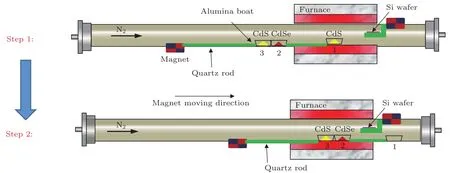
图1 (网刊彩色)生长CdS/CdSSe轴向异质结纳米线样品的实验过程示意图Fig.1.(color on line)The setup schem atic for the grow th of CdS/CdSSe axial nanow ire heterostructures.
3 实验结果与分析
图2(a)是所得样品的扫描电子显微镜(SEM)图像,由图可知样品形貌均为线状,且线的长度可达数十微米.单根纳米线高倍SEM表征(见插图)进一步表明纳米线的直径大约200 nm,并且纳米线具有光滑的表面.顶端的纳米颗粒为催化剂Au颗粒,这表明此纳米线以气-液-固(VLS)机制生长[26].图2(b)为原基片上的纳米线在405 nm激光照射下的微区荧光显微图像,由图可知每根纳米线具有绿色和红色两种发光部分.为了进一步研究纳米线组分分布,我们利用微探针操控技术将纳米线分散在透明石英衬底上.图2(c)为分散后的纳米线在405 nm激光照射下的微区荧光显微图像,由图可以清晰地观察到每根纳米线均具有界限清晰的绿色和红色两部分.图2(d)是对应于图2(c)中所标注位置1—5的微区荧光光谱.对应于红色部分的位置1和2的发光为峰值在605 nm的单一发光峰光谱;对应于绿色部分的位置4和5的发光为峰值在515 nm的单一发光峰光谱;对应于结区的位置3的发光同时具有605 nm和515 nm两个发光峰.515 nm和605 nm的发光峰分别与CdS和CdS0.48Se0.52的近带边发光相一致[27,28].结果表明这些纳米线是由CdS和CdSSe沿轴向方向构成的异质结,并且界面清晰.这些荧光光谱中没有明显的缺陷发光带,只有近带边发光峰,说明制备的CdS/CdS0.48Se0.52轴向异质结纳米线具有高的结晶质量.
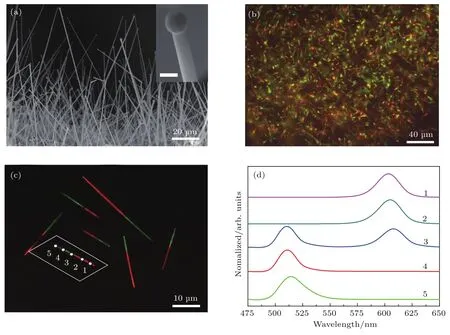
图2 (网刊彩色)(a)CdS/CdSSe异质结纳米线的SEM图,插图为单根纳米线的高倍SEM图(标尺为200 nm); (b)在405 nm激光激发下原衬底上纳米线异质结的微区荧光显微图像;(c)分散在石英衬底上的纳米线在405 nm激光激发下的远场显微图像;(d)对应(c)中单异质结纳米线不同位置(位置1—5)的微区光致发光光谱Fig.2.(color on line)(a)SEM im age of the as-grown heterostructure nanow ires,the inset is the en larged SEM im age of an single nanow ire w ith catalyst(scale bar:200 nm);(b)top-view of the real-color m icroscope photograph of the nanow ires illum inated w ith 405 nm laser;(c)the real-color m icroscope photograph of several dispersed nanow ire excited w ith d iff used 405 nm laser illum ination;(d)m icro-photolum inescence spectra for the position 1–5 denoted in(c).
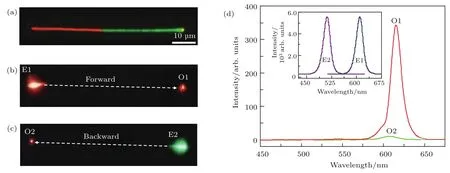
图3 (网刊彩色)(a)在405 nm激光激发下纳米线微区荧光显微图像;(b),(c)488 nm激光聚焦在纳米线两端点激发时的显微图像,E1,E2表示激发端点,O 1,O 2表示波导光出射端点;(d)O 1,O 2的发射光谱,插图为E1,E2的发射光谱Fig.3.(color on line)(a)Real-color m icroscope photograph of the rep resentative heterostructure nanow ire under the illum ination of a diff used 405 nm laser;(b),(c)real-color m icroscope im ages of the nanow ire in (a)excited at the end of CdSSe and CdS,respectively,by a focused laser of 488 nm,and O 1,O 2 denote the rem ote ends for light guiding ou t;(d)the spectra of the light em itted from O 1 and O 2,the inset is the em ission spectra for the excitation positions of E1 and E2.
为了研究CdS/CdSSe轴向异质结纳米线光波导特性,我们选择其中一根纳米线为研究对象(见图3(a)).利用光斑直径大约为300 nm的488 nm激光分别激发在纳米线的CdSSe部分的端点(激发端点E1,见图3(b))及CdS部分的端点(E2,见图3(c)).当光激发点在E1时,远端O1(出射端点)发出与激发点相同颜色的红光.这说明CdSSe的发光可以被波导至远端(正向波导).而当光激发点在E2时,远端O2发出红色光,而E2为绿色.这是因为CdS的发光在波导过程中被CdSSe吸收,再发射出红光,并被波导至O2(反向波导).图3(d)为O1和O2对应的发光光谱.为了便于比较两种波导方向的波导效率,我们通过调控激发光的强度使激发点E1和E2的发光强度相同(见插图).尽管E1和E2的发光波长不同(见插图),但是O1和O2具有基本相同的发光波长.这与图3(b)和图3(c)相一致.另外,O1的发光峰值强度大约是O2的10倍,这表明CdS/CdSSe轴向异质结纳米线对红光的波导效率要高于绿光,即正向波导效率高于反向波导.在组分均一的纳米线中,波导效率与方向无关,而仅与波导距离有关.而此轴向异质结纳米线由两部分带隙不同的材料构成.当激发窄带隙端(CdSSe)时,其发光的光子能量小于宽禁带部分(CdS),故可以直接通过宽禁带部分而不被吸收,形成无源波导.而当激发宽带隙端(CdS)时,其发光将被窄禁带部分(CdSSe)吸收,然后再发射出低能量光子,形成有源波导.对于无源波导,其损耗只有传输损耗主要由结构无序性所导致的界面和表面散射[25,29,30].而对于有源波导,除了上述损耗外,主要损耗来自于吸收-再发射过程中的无辐射过程[19].由于这两种不同的传输机制导致正向和反向传输具有不同的传输效率.
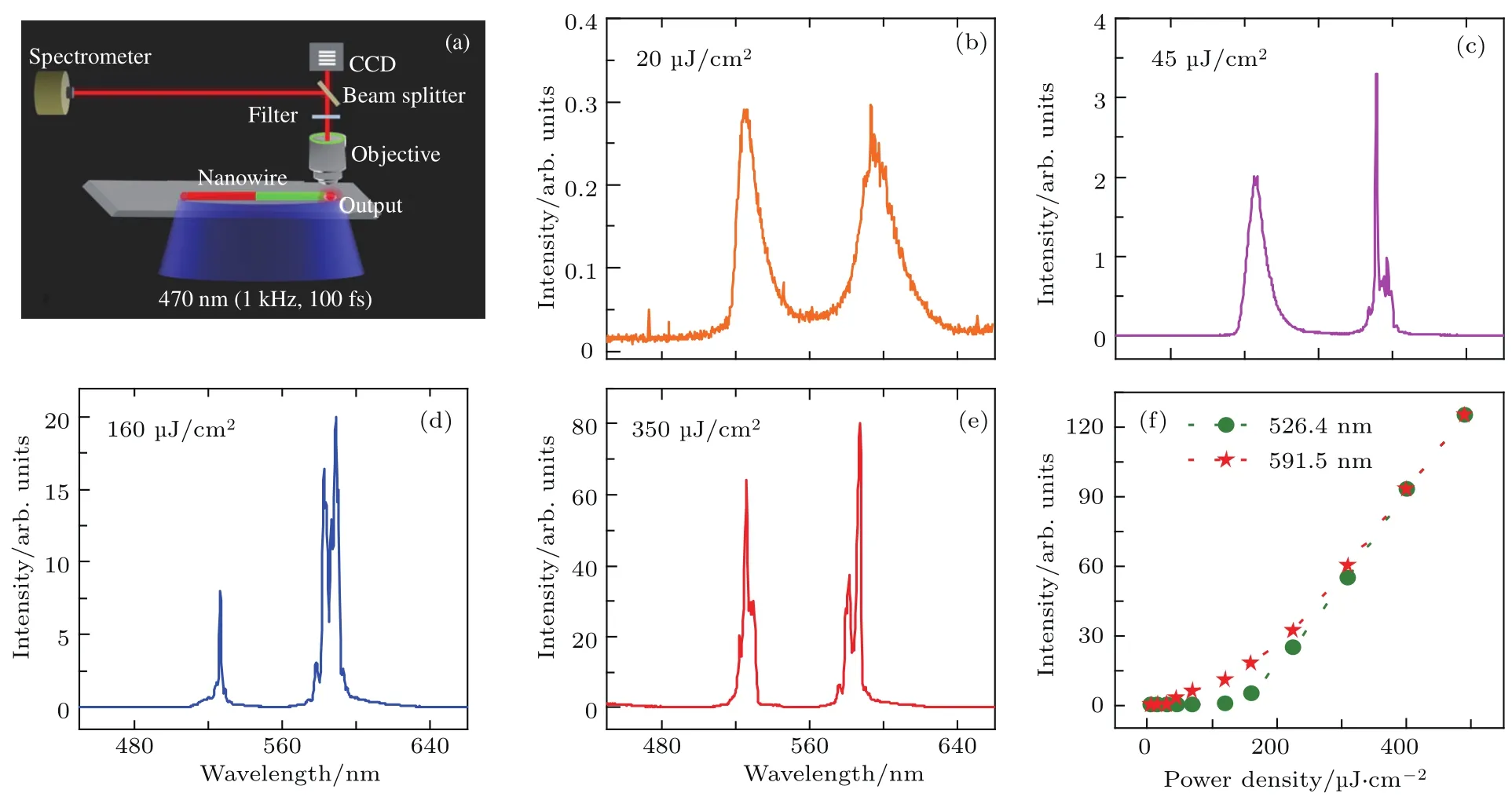
图4 (网刊彩色)(a)在共聚焦近场显微镜下的光学测试实验装置示意图;(b)—(e)纳米线异质结在抽运光激发下,不同激发强度下材料的光致发光光谱;(f)绿光(圆点)和红光(五角星)发射带的发光强度随抽运光强度的变化Fig.4.(color on line)(a)Schem atic of the experim ental setup for the lasing m easurem ents based on single CdS/CdSSe nanow ire heterostructu re;(b)–(e)pum ping power-dependent photolum inescence spectra for a rep resentative CdS/CdSSe nanow ire heterostructu re;(f)pum p ing power-dependent em ission intensity of a representative CdS/CdSSe nanow ire heterostructure for green(dots)and red(red pentagram s)em ission band,respectively.
由于纳米线具有平整的自然断裂端面,这些端面可以形成天然的反光镜,将部分到达端面的波导光反射回波导腔.由于半导体的自吸收效应,使得半导体纳米线还可以作为增益介质[21,24,31,32].根据激射产生的原理,当增益等于损耗时,就会产生受激发射[33−35].基于上述讨论,CdS/CdSSe轴向异质结纳米线可以作为性能优异的波导腔,并且同时具有对两个不同波段光的不同波导效率.所以,对其不同激发功率下的纳米线发射光谱的研究可以进一步理解波导光在异质结纳米线中与物质的相互作用.图4(a)是激射过程测试装置图,利用470 nm飞秒激光(spectra physics, 1 kHz)作为激发光源,通过透镜聚焦至80µm直径的光斑将纳米线全部照明.发光信号经过显微镜收集,进入CCD光谱仪检测.图4(b)—(e)为不同激发功率下的发光光谱,由图可知,在低激发功率(20µJ/cm2,图4(b))下,发射光谱为中心波长在520 nm和600 nm附近的宽带发射带,这是典型的自发辐射光谱[19−21].当激发功率增加到45µJ/cm2时(图4(c)),在591.5 nm波长处开始出现了一个尖峰.当激发功率达到160µJ/cm2时(图4(d)),在526.4 nm波长处同时出现了激射峰.并且随着激发功率的进一步增强,尖峰的强度迅速增加,最终将自发辐射全部掩盖(图4(e)),这对应着受激辐射的过程特征[17−19,36].图4(f)是两个发射带峰值强度随激发功率的变化.红光发射带和绿光发射带发射强度与激发功率关系曲线的斜率分别在45µJ/cm2和160µJ/cm2处呈现了超线性关系,这表明红光发射带的激射阈值远低于绿光发射带.这是由于对于红光发射带,其自吸收损耗只发生在CdSSe部分,而对于绿光发射的自吸收则不仅发生在CdSSe部分,还发生在CdS部分,因为CdSSe的带隙远低于绿光发射光子能量.另一方面,绿光发射在CdSSe部分的自吸收还进一步增强了红光发射带的增益.基于这些原因,红光发射的激射阈值远低于绿光发射带的激射阈值.
为了进一步证明波导光可以在纳米线中不同介质(CdS和CdSSe)间波导,我们利用多物理场方法(COMSOL)对CdS/CdSSe轴向异质结纳米线中的光波导进行了模拟.图5(a)是所建模型图,其中左半部为CdS部分,右半部为CdSSe部分,长度均为2µm,直径为200 nm;通过不同折射率区分两部分介质,CdS折射率为2.5,CdSSe为3.0[37].图5(b)和图5(c)是分别从纳米线的两端入射526.4 nm和591.5 nm光的波导模拟结果.尽管CdSSe折射率要大于CdS折射率,从模拟结果可以清楚地看到无论是绿光从CdS进入CdSSe,还是红光从CdSSe进入CdS,均可以进入另一介质,并基本不改变光场强度.这表明CdS发射的绿光可以高效地进入并激发CdSSe,这也是图3(c)中CdS端(E2)激发,在远端(O2)出射红光的原因,同时也是红光激射阈值低于绿光的原因.尤其是CdSSe中的红光发射从高折射率CdSSe进入低折射率CdS并没有对光的强度有明显的影响,表明红光可以在整个纳米线中波导,这与图3(b)中的结果一致.
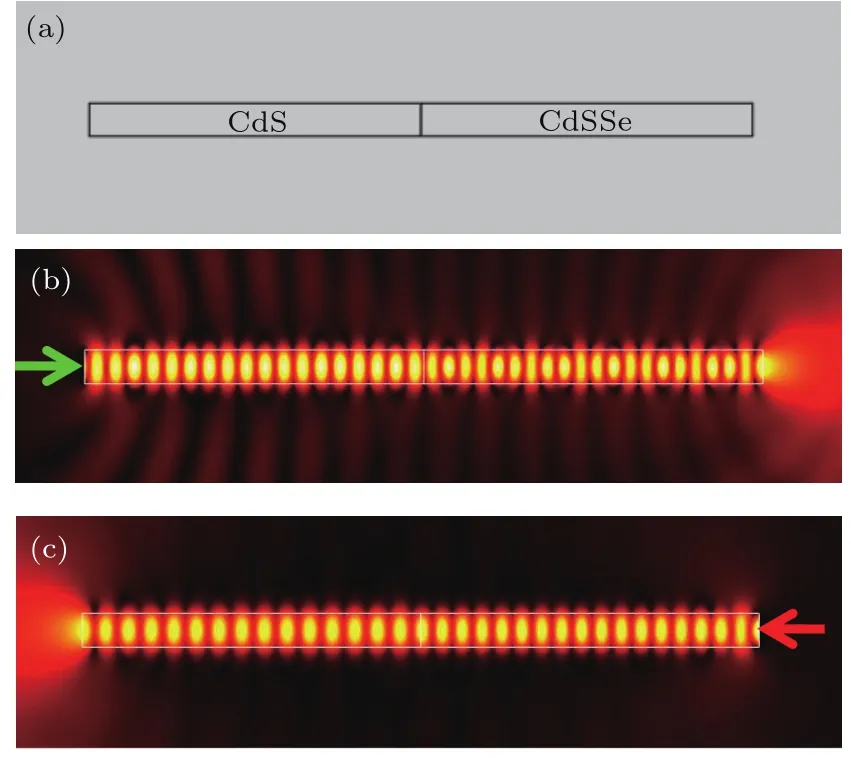
图5 (网刊彩色)不同波长光在CdS/CdSSe异质结纳米线中波导的理论模拟结果(COMSOL)(a)拟合建立的模型图,左边为CdS部分,右边为CdSSe部分; (b)526.4 nm光从CdS端点入射和(c)591.5 nm光从CdSSe入射的波导模拟结果Fig.5. (color on line)Sim u lation resu lts of the waveguide in the CdS/CdSSe axial nanow ire heterostructu res: (a)The m odel for the sim u lation,CdS and CdSSe com ponents locate at left and right side,respectively;(b)the sim u lation resu lt of the waveguide for 526.4 nm light incident from the end of CdS com ponent;(c)the sim u lation resu lt of the waveguide for 591.5 nm light incident from end of CdSSe com ponent,respectively.The arrow s indicate the incidence direction of the light.
4 结 论
本文采用CVD法成功地制备出CdS/CdS0.48-Se0.52轴向异质结纳米线.单根纳米线的光波导研究表明,该异质结构具有非对称光波导特性.由于CdS/CdSSe轴向异质结纳米线可以作为性能优异的波导腔,并且同时具有对两个不同波段光的不同波导效率,利用此原理,我们实现了基于此异质结构的红、绿双色纳米线激光器,并且红光激射阈值远低于绿光激射阈值.理论模拟结果表明,在此异质结纳米线结果中,尽管CdS和CdSSe折射率不同,但是波导光可以高效地在两相间波导.该纳米线异质结构在双色纳米线激光器、光互联等光子学方面有潜在的应用.
[1]Faist J,Capasso F,Sivco D L,Sirtori C,Hu tchinson A L,Cho A Y 1994 Science 264 553
[2]Slight T J,Rom eira B,W ang L,Figueiredo J M L, W asige E,Ironside C N A 2008 IEEE J.Quantum Elect. 44 1158
[3]H iyam izu S,M im ura T 1982 J.Cryst.Grow th 56 455
[4]Harrison T R,Tait G B,M cAdoo J A 2005 Proc.SPIE 5732 342
[5]Nylund G,Storm K,Lehm ann S,Capasso F,Sam uelson L 2016 Nano Lett.16 1017
[6]de la M ata M,M agen C,Caroff P,A rbiol J 2014 Nano Lett.14 6614
[7]Gudiksen M S,Lauhon L J,Wang J,Sm ith D C,Lieber C M 2002 Nature 415 617
[8]W u Y,Fan R,Yang P 2002 Nano Lett.2 83
[9]Flynn G,Ram asse Q M,Ryan K M 2016 Nano Lett.16 374
[10]B jörk M T,Oh lsson B J,Sass T,Persson A I,Thelander C,M agnusson M H,Deppert K,W allenberg L R, Sam uelson L 2002 Nano Lett.2 87
[11]Fan C,Zhang Q L,Zhu X L,Zhuang X J,Pan A L 2015 Sci.Bull.60 1674
[12]Guo S,Li Z S,Song G L,Zou B S,W ang X X,Liu R B 2015 J.A lloys Com pd.649 793
[13]Tan H,Fan C,M a L,Zhang X H,Fan P,Yang Y K, Hu W,Zhou H,Zhuang X J,Zhu X L,Pan A L 2016 Nano-M icro Lett.8 29
[15]M a L,Zhang X H,Li H L,Tan H,Yang Y K,Xu Y D, Hu W,Zhu X L,Zhuang X J,Pan A L 2015 Sem icond. Sci.Techno l.30 10
[16]Li J J,Gao Z Y,Xue X W,Li H M,Deng J,Cui B F, Zou D S 2016 Acta Phys.Sin.65 118104(in Chinese) [李江江,高志远,薛晓玮,李慧敏,邓军,崔碧峰,邹德恕2016物理学报65 118104]
[17]Zheng D S,W ang J L,Hu W D,Liao L,Fang H H,Guo N,W ang P,Gong F,W ang X D,Fan Z Y,W u X,M eng X J,Chen X S,Lu W 2016 Nano Lett.16 2548
[18]Zheng D S,Fang H H,W ang P,Luo W J,Gong Fan,Ho J C,Chen X S,Lu W,Liao L,W ang J L,Hu W D 2016 Adv.Funct.M ater.26 7690
[19]Pan A L,W ang S Q,Liu R B,Li C R,Zou B S 2005 Sm a ll 1 1058
[20]W ang X,Pan A L,Liu D,Bai Y Q,Zhang Z H,Zou B S,Zhu X 2007 Acta Phys.Sin.56 6352(in Chinese)[王笑,潘安练,刘丹,白永强,张朝晖,邹炳锁,朱星2007物理学报56 6352]
乡土正义是把握乡村社会法律秩序的重要窗口。本文力图管中窥豹,以纠纷社会文本为切口,着重讨论乡土正义命题及其嬗变背后的社会秩序问题,以下是一个初步的总结与讨论。
[21]Zhang Q L,Zhu X L,Li Y Y,Liang JW,Chen T R, Fan P,Zhou H,Hu W,Zhuang X J,Pan A L 2016 Laser Photon.Rev.10 458
[22]Zhang Q L,Liu H W,Guo P F,Li D,Fan P,Zheng W H,Zhu X L,Jiang Y,Zhou H,Hu W,Zhuang X J,Liu H J,Duan X F,Pan A L 2017 Nano Energy 32 28
[23]Zhang Q L,W ang SW,Liu X X,Chen T R,Li H F, Liang J W,Zheng W H,Agarwal R,Lu W,Pan A L 2016 Nano Energy 30 481
[24]Pan A L,Zhou W C,Leong E S P,Liu R B,Chin A H, Zou B S,Ning C Z 2009 Nano Lett.9 784
[25]Sirbu ly D J,Law M,Pauzauskie P,Yan H,M aslov A V, K nu tsen K,Ning C Z,Saykally R J,Yang P 2005 Proc. Natl.Acad.Sci.USA 102 7800
[26]Pan ZW,Dai Z R,M a C,Wang Z L 2002 J.Am.Chem. Soc.124 1817
[27]Pan A L,Yang H,Liu R B,Yu R C,Zou B S,Wang Z L 2005 J.Am.Chem.Soc.127 15692
[28]Pan A L,W ang X X,He P B,Zhang Q L,W an Q, Zacharias M,Zhu X,Zou B S 2007 Nano Lett.7 2970
[29]Xu J Y,Zhuang X J,Guo P F,Huang W Q,Hu W, Zhang Q L,W an Q,Zhu X L,Yang Z Y,Tong L M, Duan X F,Pan A L 2012 Sci.Rep.2 820
[30]Xu J Y,Zhuang X J,Guo P F,Zhang Q L,M a L,W ang X X,Zhu X L,Pan A L 2013 J.M ater.Chem.C 1 4391 [31]Yan H,Choe H S,Nam SW,Hu Y J,Das S,K lem ic J F,llenbogen J C,Lieber C M 2011 Nature 470 240
[32]Duan X F,Huang Y,Cui Y,W ang J F,Lieber C M 2001 Nature 409 66
[33]Li J B,M eng C,Liu Y,W u X Q,Lu Y Z,Ye Y,Dai L, Tong L M,Liu X,Yang Q 2013 Adv.M ater.25 833
[34]Guo P F,Zhuang X J,Xu J Y,Zhang Q L,Hu W,Zhu X L,W ang X X,W an Q,He P B,Zhou H,Pan A L 2013 Nano Lett.13 1251
[35]Zimm ler M A,Bao J,Capasso F,M u ller S,Ronning C 2008 Appl.Phys.Lett.93 051101
[36]Zhuang X J,Guo P F,Zhang Q L,Liu H W,Li D,Hu W,Zhu X L,Zhou H,Pan A L 2016 Nano Res.9 933
[37]Jensen B,Torabi A 1986 J.Opt.Soc.Am.B 3 857
PACS:42.55.–f,42.55.Px,42.82.–m,42.82.EtDOI:10.7498/aps.66.064204
A symm etric w avegu ide and the dual-w avelength stim u lated em ission for Cd S/Cd S0.48Se0.52ax ial nanow ire heterostructu res∗
Li Dan1)Liang Jun-Wu2)Liu Hua-Wei1)Zhang Xue-Hong1)Wan Qiang1)Zhang Qing-Lin1)†Pan An-Lian1)‡
1)(Key Laboratory for M icro-Nano Physics and Technology of Hunan Province,School of Physics and Electronics, Hunan University,Changsha 410082,China)
2)(School of Physical Science and Technology Engineering,Yu lin Norm al University,Yu lin 537000,China)
(Received 6 Novem ber 2016;revised m anuscrip t received 17 Decem ber 2016)
Sem iconductor axial nanow ire heterostructures are im portant for realizing the high-perform ance nano-photonics and opto-electronics devices.A lthough diff erent IV and III-V sem iconductor axial nanow ire heterostructures have been successfully prepared in recent decade,few of them focused on the optical properties,such as thewaveguide,due to their low light em ission effi ciencies.The II-V I sem iconductor nanow ires grown by chem ical vapor deposition strategy,such as CdS,CdSe and their alloys,can act as nanoscale waveguide,nanolasers,etc.,because of their high op tical gains and atom ically sm ooth surfaces.However,it is stilla challenge to grow ing the high-quality II-V Isem iconductor axialnanow ire heterostructures,owning to the poor controllability of the vapor grow th techniques.Here,the CdS/CdSSe axialnanow ire heterostructures are prepared w ith well controlled CVD method under the catalysis of annealed Au nanoparticles.The scanning electron m icroscope characterization show s that the w ires have sm ooth surfaces w ith Au particles at the tips, indicating the vapor-liquid-solid grow th m echanism for the nanow ire heterostructures.The m icroscope im ages of the dispersed w ires illum inated w ith a 405 nm laser show that the red and the green segm ent align axially w ith a sharp interface,demonstrating the axial alignment of CdSand CdSSe segments.The position related m icro-photolum inescence spectra exhibit near band edge em issions of CdS and CdSSe w ithout obvious em ission from defect states,which suggests that the w ires have highly crystalline quality.The waveguide of the nanow ire heterostructures is studied through respectively locally exciting the two ends of the w ire w ith a focused 488 nm laser.The local illum inations at both the CdS end and the CdSSe end resu lt in red em ission at the corresponding remote ends of the w ires,w ith the em ission intensity of the former being one order lower than that of the later,which is caused by the reabsorption of the green light em ission(from CdS segm ent)in the CdSSe segm ent.This indicates the asymm etric waveguide in these heterosturctures, which im p lies that the CdS/CdSSe nanow ire heterostructures have the potential app lications in the photodiode.Under the pum ping of 470 nm fem tosecond laser,dual-color(red and green)lasing is realized based on these w ires,w ith the lasing threshold of red light lasing being lower than that of the green one,which results from the larger round-trip loss for the green light arising from the self-absorp tion in CdSSe segment.To prove that the light can be transfer between the two segm entsw ith diff erent refractivities,the waveguide of the nanow ire heterostructure is simulated by the COM SOL.The resu lt show s that the light can eff ectively propagate between CdS and CdSSe segm ents,which ensures the light-m atter interaction in the axial CdS/CdSSe nanow ire heterostructures as discussed above.These high-quality CdS/CdSSe axial nanow ire heterostructures can be found to have the potential app lications in photodiodes,dual-color nanolasers and photodetectors.
nanow ires,heterostructure,waveguide,lasers
10.7498/aps.66.064204
∗国家自然科学基金(批准号:11374092,61474040,61574054,61505051)资助的课题.
†通信作者.E-m ail:qinglin.zhang@hnu.edu.cn
‡通信作者.E-m ail:an lian.pan@hnu.edu.cn
*Pro ject supported by the National Natu ral Science Foundation of China(G rant Nos.11374092,61474040,61574054, 61505051).
†Corresponding au thor.E-m ail:qinglin.zhang@hnu.edu.cn
‡Corresponding au thor.E-m ail:an lian.pan@hnu.edu.cn

